spare tire LEXUS NX300h 2015 Owners Manual
[x] Cancel search | Manufacturer: LEXUS, Model Year: 2015, Model line: NX300h, Model: LEXUS NX300h 2015Pages: 681, PDF Size: 9.14 MB
Page 104 of 681

104 2. Instrument cluster
NX300h_U_OM78007U ■
Average vehicle speed (after reset
* 2
/a f t e r s t a r t )
* 1
Displays the average vehicle speed since the function was reset and the
hybrid system was started, respectively ■
Elapsed time (after reset
* 2
/after start)
* 1
Displays the elapsed time since the function was reset and the hybrid system
was started, respectively ■
Distance (driving range/after start)
* 1
Displays the estimated maximum distance that can be driven with the quantity
of fuel remaining and the distance driv en after the hybrid system was started
respectively. • This distance is computed based on your average fuel consumption. As a result,
the actual distance that can be driven may differ from that displayed.
• When only a small amount of fuel is added to the tank, the display may not be
updated.
When refueling, turn the power switch off. If the vehicle is refueled without turning
the power switch off, the display may not be updated.■
Energy monitor
P. 1 1 1■
Tire inflation pressure
Displays inflation pressure of each tire. The inflation pressure of the spare tire will not be displayed.■
Display off
A blank screen is displayed
* 1
: Displayed when the item is set in “D rive Info 1” or “Drive Info 2”. ( P. 6 3 8 )
* 2
: The function can be reset by pressing th e of the meter control switches for longer
than 1 second when the item to reset is displayed.
If there is more than one item that can be reset, the item selection screen will appear.
Page 197 of 681

1974-1. Before driving
4
Driving
NX300h_U_OM78007U WA R N I N G ■
Trailer towing precautions
To tow a trailer safely, use extreme care and drive the vehicle in accordance with the
trailer’s characteristics and op erating conditions. Failure to do so could cause an acci-
dent resulting in death or serious injury. Vehicle stability and braking performance are
affected by trailer stability, brake setting and performance, and the hitch. Your vehicle
will handle differently when towing a trailer. ■
To avoid accident or injury ●
Do not exceed the TWR, unbrak ed TWR, GCWR, GVWR or GAWR.●
Adjust the tongue weight within the approp riate range. Place heavier loads as close
to the trailer axle as possible. ●
Do not exceed 65 mph (104 km/h), the posted towing speed limit or the speed limit
for your trailer as set forth in your trailer owner’s manual, whichever is lowest. Slow
down sufficiently before making a turn, in cr oss winds, on wet or slippery surface, etc.
to help avoid an accident. If you experience a vehicle-trailer instability from reducing
a certain speed, slow down and make sure you keep your vehicle speed under the
speed of which you expe rience the instability.●
Do not make jerky, abrupt or sharp turns. ●
Do not apply the brakes suddenly as you ma y skid, resulting in ja ckknifing and loss of
vehicle control. This is especially true on wet or slippery surfaces. ●
Do not exceed the trailer hitch assembly weight, gross vehicle weight, gross axle
weight and trailer tongue weight capacities. ●
Do not use the following systems when trailer towing.
• Cruise control (if equipped)
• Dynamic radar cruise control (if equipped)
• Dynamic cruise control with full-speed range (if equipped)●
Slow down and downshift before descending steep or long downhill grades. Do not
make sudden downshifts while descen ding steep or long downhill grades.●
Vehicle-trailer instability is more likely on steep long downhills. Before descending
steep or long downhill grades, slow down and downshift. Do not make sudden down-
shifts when descending stee p or long downhill grades. Avoid holding the brake pedal
down too long or applying the brakes too frequently. This could cause the brakes to
overheat and result in reduced braking efficiency. ●
Vehicles with a compact spare tire: Do no t tow a trailer when the compact spare tire
is installed on your vehicle. ■
Hitch
Trailer hitch assemblies have different weight capacities established by the hitch manu-
facturer. Even though the vehicle may be physically capable of towing a higher weight,
the operator must determine the maximum weig ht rating of the particular hitch assem-
bly and never exceed the maximum weight rating specified for the trailer-hitch.
Exceeding the maximum weight rating set by the trailer-hitch manufacturer can cause
an accident resulting in death or serious personal injuries.
Page 277 of 681

2774-5. Using the driving support systems
4
Driving
NX300h_U_OM78007U WA R N I N G ■
Before using the LDA
Do not over rely on the LDA. The LDA does not drive the vehicle automatically, nor
does it reduce the amount of care you need to take. As such, the driver must always
assume full responsibility for understandin g his/her surroundings, for operating the
steering wheel to correct the driving line, and for driving safely. Also, take occasional
rests from fatigue due to driving over long periods of time, etc.
Inappropriate or negligent driving co uld lead to an unexpected accident.■
Do not drive without holding the steering wheel
While the steering control function is operating, when the system judges that the vehi-
cle is being driven without holding the steering wheel, a warning message is displayed.
( P. 2 7 1 )
Inappropriate steering wheel operations and/or negligent driving could lead to an
unexpected accident. When driving, firmly ho ld the steering wheel and keep safe driv-
ing in mind. ■
To avoid operating the LDA by mistake
Switch the LDA off using the LDA switch when not in use. ( P. 2 7 2 )■
Situations unsuitable for LDA
Do not use the LDA in any of the following situations.
Otherwise, the system may not function correctly and could result in an accident. ●
When driving with snow tires, tire ch ains, a spare tire, or similar equipment●
When a tire with a different structure, maker, brand, or tread pattern is used. ●
When remain tread of the tire or the air pressure is insufficient●
When restructuring the suspension ●
When there are objects or structures along the roadside that might be misinterpreted
as lane markers (such as guardrails, a curb, reflector posts, etc.) ●
When driving on snowy roads ●
When pavement lane markers are difficult to see due to rain, snow, fog, sand, dust,
etc. ●
When there are visible lines on the pavement from road repairs, or if the remains of
old lane markers are still visible on the road ●
When driving on a road with lane closures due to maintenance, or when driving in a
temporary lane ●
When driving on road surfaces that are slippery from rain, snow, etc.●
When driving in traffic lanes other than highways and freeway ●
When driving through construction areas
Page 451 of 681
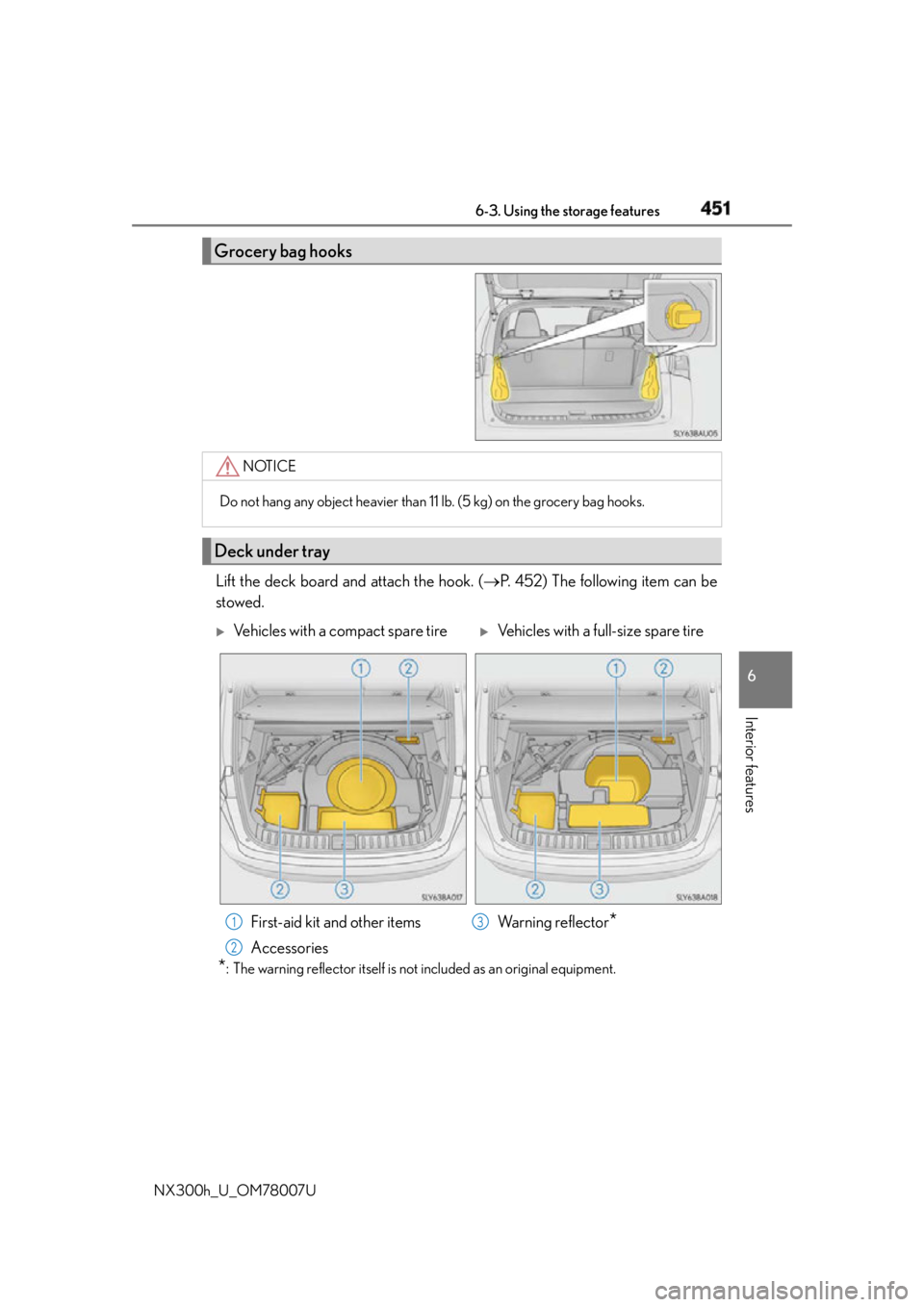
4516-3. Using the storage features
6
Interior features
NX300h_U_OM78007U Lift the deck board and attach the hook. ( P. 452) The following item can be
stowed.
* : The warning reflector itself is not included as an original equipment.Grocery bag hooks
NOTICE
Do not hang any object heavier than 11 lb. (5 kg) on the grocery bag hooks.
Deck under tray
Vehicles with a compact spare tire
Vehicles with a full-size spare tire
First-aid kit and other items
Accessories Wa r n i n g r e f l e c t o r
*1
2 3
Page 516 of 681
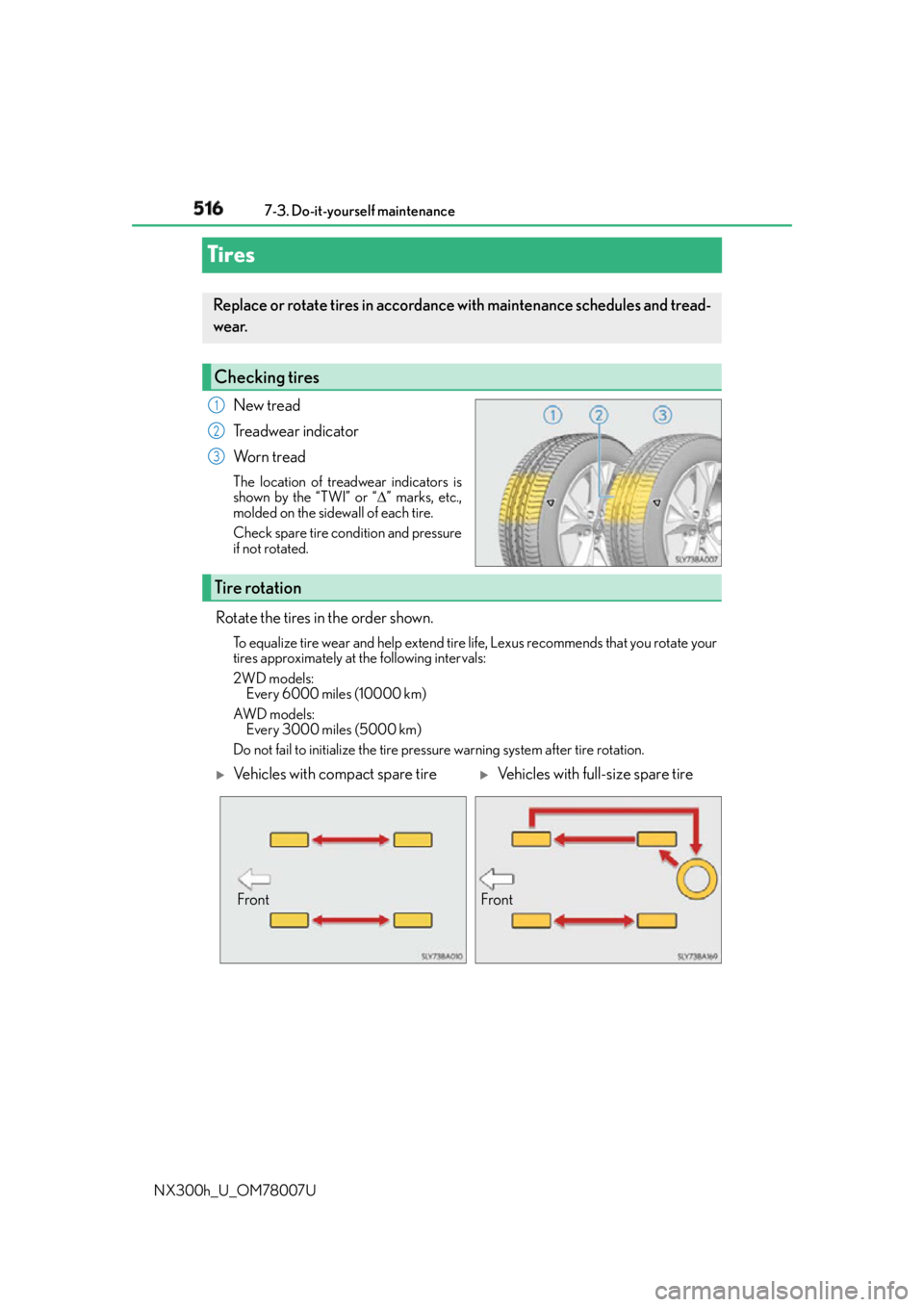
516 7-3. Do-it-yourself maintenance
NX300h_U_OM78007UTires New tread
Treadwear indicator
Wo r n t r e a d The location of treadwear indicators is
shown by the “TWI” or “ ” marks, etc.,
molded on the sidewall of each tire.
Check spare tire condition and pressure
if not rotated.
Rotate the tires in the order shown. To equalize tire wear and help extend tire life, Lexus recommends that you rotate your
tires approximately at the following intervals:
2WD models:
Every 6000 miles (10000 km)
AW D m o d e l s :
Every 3000 miles (5000 km)
Do not fail to initialize the tire pressu re warning system after tire rotation.Replace or rotate tires in accordance with maintenance schedules and tread-
wear.
Checking tires 1
2
3
Tire rotation
Vehicles with compact spare tire
Vehicles with full-size spare tire
Front Front
Page 523 of 681
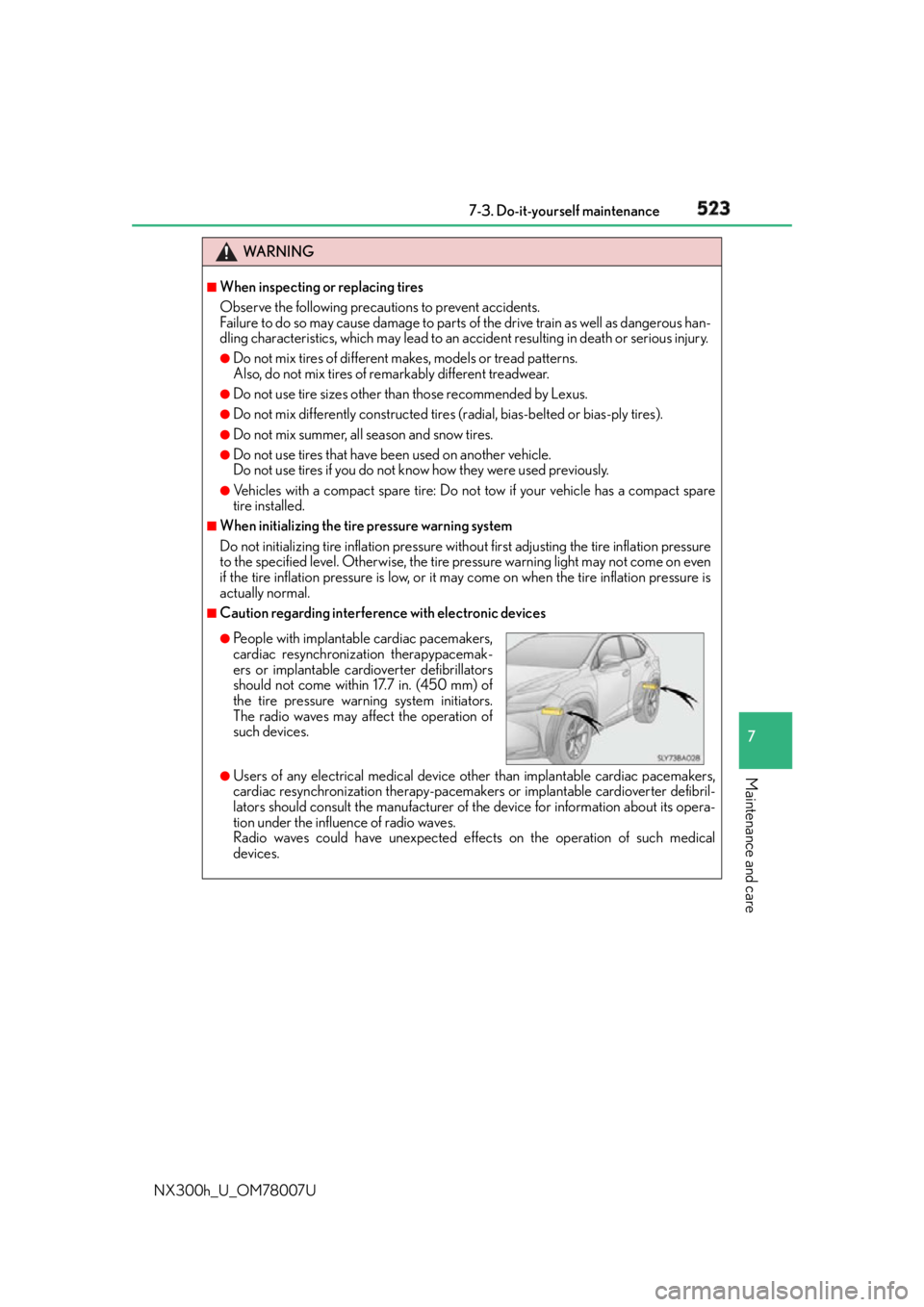
5237-3. Do-it-yourself maintenance
7
Maintenance and care
NX300h_U_OM78007U WA R N I N G ■
When inspecting or replacing tires
Observe the following precautions to prevent accidents.
Failure to do so may cause damage to parts of the drive train as well as dangerous han-
dling characteristics, which may lead to an accident resultin g in death or serious injury.●
Do not mix tires of different makes, models or tread patterns.
Also, do not mix tires of remarkably different treadwear. ●
Do not use tire sizes other than those recommended by Lexus. ●
Do not mix differently constructed tires (radial, bias-belted or bias-ply tires). ●
Do not mix summer, all season and snow tires. ●
Do not use tires that have been used on another vehicle.
Do not use tires if you do not know how they were used previously. ●
Vehicles with a compact spare tire: Do no t tow if your vehicle has a compact spare
tire installed. ■
When initializing the tire pressure warning system
Do not initializing tire inflation pressure wi thout first adjusting the tire inflation pressure
to the specified level. Otherwise, the tire pressure warning light may not come on even
if the tire inflation pressure is low, or it may come on when the tire inflation pressure is
actually normal. ■
Caution regarding interference with electronic devices
●
Users of any electrical medical device other than implantable cardiac pacemakers,
cardiac resynchronization therapy-pacemakers or implantable cardioverter defibril-
lators should consult the ma nufacturer of the device for information about its opera-
tion under the influence of radio waves.
Radio waves could have unexpected effe cts on the operation of such medical
devices. ●
People with implantable cardiac pacemakers,
cardiac resynchronization therapypacemak-
ers or implantable cardioverter defibrillators
should not come within 17.7 in. (450 mm) of
the tire pressure warning system initiators.
The radio waves may affect the operation of
such devices.
Page 526 of 681
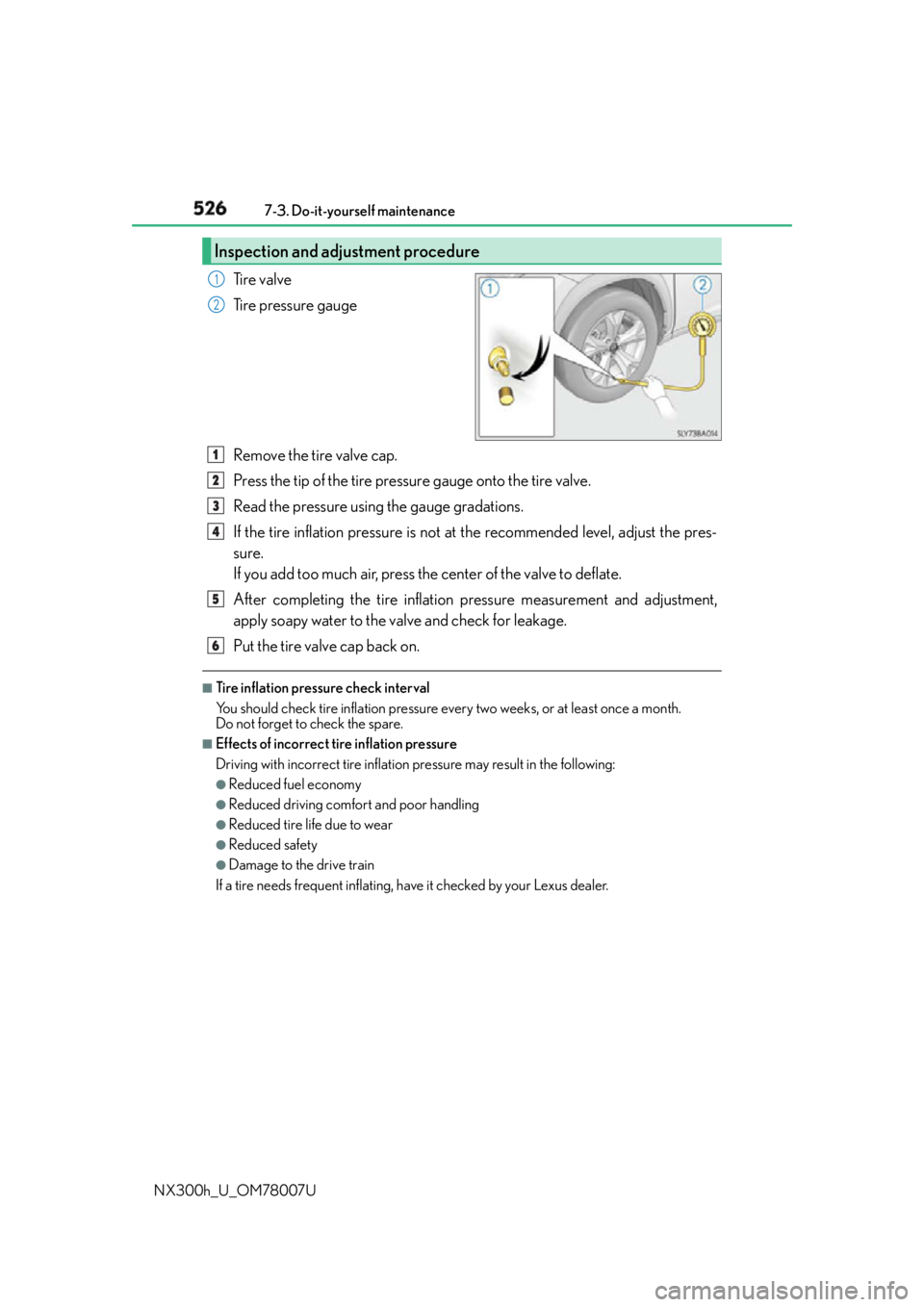
526 7-3. Do-it-yourself maintenance
NX300h_U_OM78007U Tire valve
Tire pressure gauge
Remove the tire valve cap.
Press the tip of the tire pressure gauge onto the tire valve.
Read the pressure using the gauge gradations.
If the tire inflation pressure is not at the recommended level, adjust the pres-
sure.
If you add too much air, press the center of the valve to deflate.
After completing the tire inflation pressure measurement and adjustment,
apply soapy water to the valve and check for leakage.
Put the tire valve cap back on. ■
Tire inflation pressure check interval
You should check tire inflation pressure ev ery two weeks, or at least once a month.
Do not forget to check the spare. ■
Effects of incorrect tire inflation pressure
Driving with incorrect tire inflation pressure may result in the following: ●
Reduced fuel economy ●
Reduced driving comfort and poor handling ●
Reduced tire life due to wear ●
Reduced safety ●
Damage to the drive train
If a tire needs frequent inflating, have it checked by your Lexus dealer.Inspection and adjustment procedure 1
2
1
2
3
4
5
6
Page 569 of 681

5698-2. Steps to take in an emergency
8
When trouble arises
NX300h_U_OM78007U ■
When the tire pressure warning light comes on
Inspect the appearance of the tire to check that the tire is not punctured.
If the tire is punctured: P. 5 7 5
If the tire is not punctured:
Carry out the following procedure after the tire temperature has lowered sufficiently.●
Check the tire inflation pressure and adjust to the appropriate level. ●
If the warning light does not go out even after several minutes, check that the tire infla-
tion pressure is at the specified level and carry out initialization. ( P. 5 1 8 )
The warning light may come on again if the above operations are conducted without first
allowing the tire temperature to lower sufficiently. ■
The tire pressure warning light may come on due to natural causes
The tire pressure warning light may come on due to natural causes such as natural air
leaks and tire inflation pressure changes caused by temperature. In this case, adjusting
the tire inflation pressure will turn off the warning light (after a few minutes). ■
When a tire is replaced with a spare tire
Vehicles with a compact spare tire: The comp act spare tire is not equipped with a tire
pressure warning valve and transmitter. If a tire goes flat, the tire pressure warning light
will not turn off even though the flat tire ha s been replaced with the spare tire. Replace
the spare tire with the repaired tire and adjust the tire inflation pressure. The tire pressure
warning light will go off after a few minutes.
Vehicles with a full-size spare tire: The spare tire is also equipped with a tire pressure
warning valve and transmitter. The tire pressure warning light will turn on if the tire infla-
tion pressure of the spare tire is low. If a tire goes flat, the tire pressure warning light will
not turn off even though the flat tire has been replaced with the spare tire. Replace the
spare tire with the repaired tire and adjust the tire inflation pressure. The tire pressure
warning light will go off after a few minutes. ■
Conditions that the tire pressure warning system may not function properly
P. 5 2 1 ■
If the tire pressure warning light frequently comes on after blinking for 1 minute
If the tire pressure warning light frequently comes on after blinking for 1 minute when the
power switch is turned to ON mode, ha ve it checked by your Lexus dealer.■
Warning buzzer
In some cases, the buzzer may not be heard due to being in a noisy location or audio
sound.
Page 570 of 681

570 8-2. Steps to take in an emergency
NX300h_U_OM78007U WA R N I N G ■
If both the ABS and the brake system warning lights remain on
Stop your vehicle in a safe place immediat ely and contact your Lexus dealer. The vehi-
cle will become extremely unstable during braking, and the ABS system may fail, which
could cause an accident resulting in death or serious injury. ■
When the electric power steering system warning light comes on
When the light comes on yellow, the assist to the power steering is restricted. When the
light comes on red, the assist to the power steering is lost and handling operations of
the steering wheel become extremely heavy. When steering wheel operations are
heavier than usual, grip the steering wheel firmly and operate it using more force than
usual. ■
If the tire pressure warning light comes on
Be sure to observe the following precautions. Failure to do so could cause a loss of
vehicle control and result in death or serious injury. ●
Stop your vehicle in a safe place as soon as possible. Adjust the tire inflation pressure
immediately. ●
If the tire pressure warning light comes on even after tire inflation pressure adjust-
ment, it is probable that you have a flat tire. Check the tires. If a tire is flat, change it
with the spare tire and have the flat tire repaired by the nearest Lexus dealer. ●
Avoid abrupt maneuvering and braking. If the vehicle tires deteriorate, you could lose
control of the steering wheel or the brakes. ■
If a blowout or sudden air leakage should occur
The tire pressure warning system may not activate immediately.
Page 571 of 681
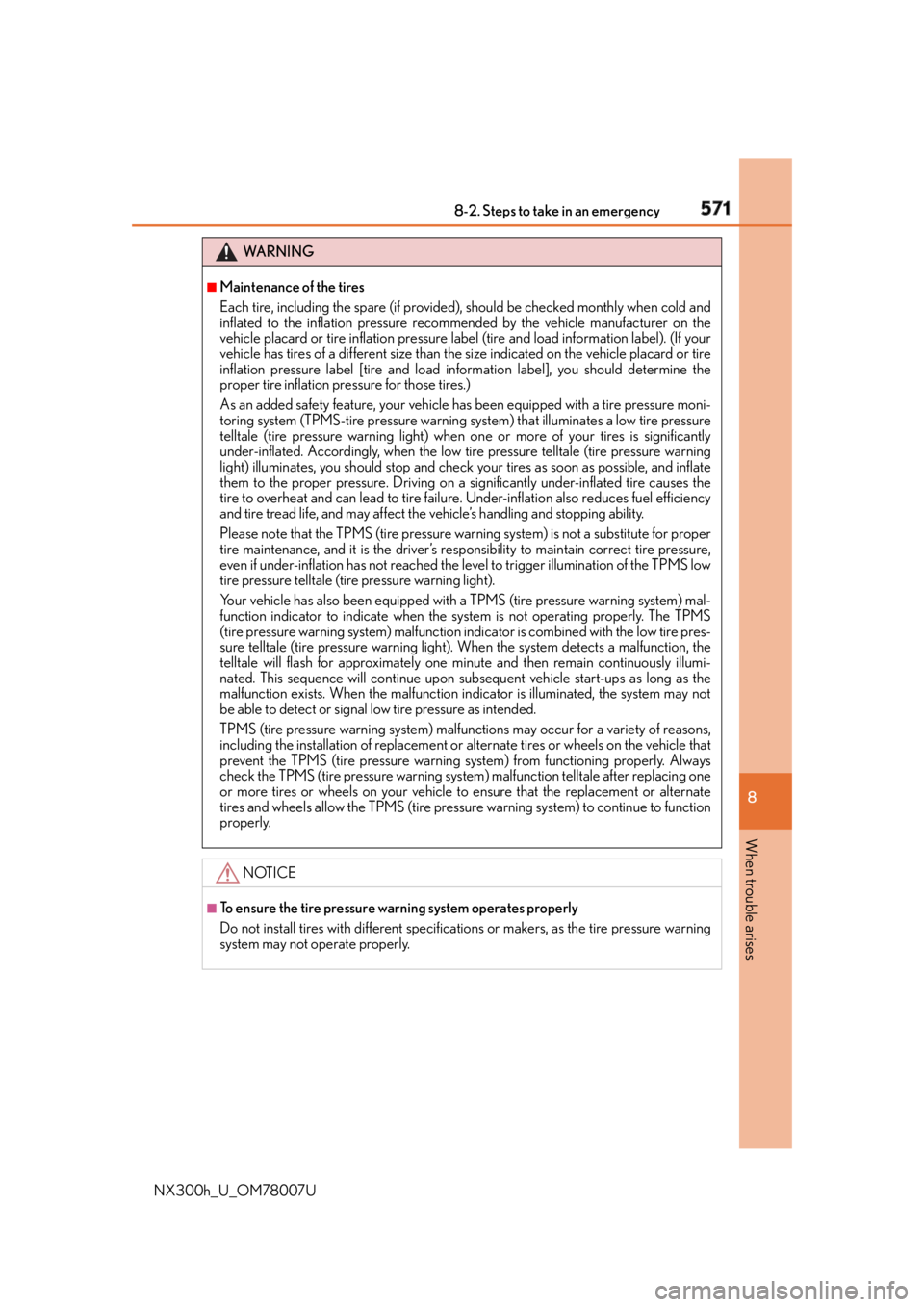
5718-2. Steps to take in an emergency
8
When trouble arises
NX300h_U_OM78007U WA R N I N G ■
Maintenance of the tires
Each tire, including the spare (if provided), should be checked monthly when cold and
inflated to the inflation pressure recomm ended by the vehicle manufacturer on the
vehicle placard or tire inflation pressure la bel (tire and load information label). (If your
vehicle has tires of a different size than the size indicated on the vehicle placard or tire
inflation pressure label [tire and load in formation label], you should determine the
proper tire inflation pressure for those tires.)
As an added safety feature, your vehicle ha s been equipped with a tire pressure moni-
toring system (TPMS-tire pressure warning system) that illuminates a low tire pressure
telltale (tire pressure warning light) when on e or more of your tires is significantly
under-inflated. Accordingly, when the low ti re pressure telltale (tire pressure warning
light) illuminates, you should stop and check your tires as soon as possible, and inflate
them to the proper pressure. Driving on a significantly under-inflated tire causes the
tire to overheat and can lead to tire failure. Under-inflation also reduces fuel efficiency
and tire tread life, and ma y affect the vehicle’s handling and stopping ability.
Please note that the TPMS (tire pressure wa rning system) is not a substitute for proper
tire maintenance, and it is the driver’s resp onsibility to maintain correct tire pressure,
even if under-inflation has no t reached the level to trigger illumination of the TPMS low
tire pressure telltale (tire pressure warning light).
Your vehicle has also been equipped with a TPMS (tire pressure warning system) mal-
function indicator to indicate when the system is not operating properly. The TPMS
(tire pressure warning system) malfunction indi cator is combined with the low tire pres-
sure telltale (tire pressure warning light). When the system detects a malfunction, the
telltale will flash for approximately one minu te and then remain continuously illumi-
nated. This sequence will cont inue upon subsequent vehicl e start-ups as long as the
malfunction exists. When the malfunction indicator is illuminated, the system may not
be able to detect or signal low tire pressure as intended.
TPMS (tire pressure warning system) malfun ctions may occur for a variety of reasons,
including the installation of replacement or alternate tires or wheels on the vehicle that
prevent the TPMS (tire pressure warning system) from functioning properly. Always
check the TPMS (tire pressure warning syst em) malfunction telltale after replacing one
or more tires or wheels on your vehicle to ensure that the replacement or alternate
tires and wheels allow the TPMS (tire pressure warning system) to continue to function
properly.
NOTICE ■
To ensure the tire pressure warning system operates properly
Do not install tires with different specificatio ns or makers, as the tire pressure warning
system may not operate properly.